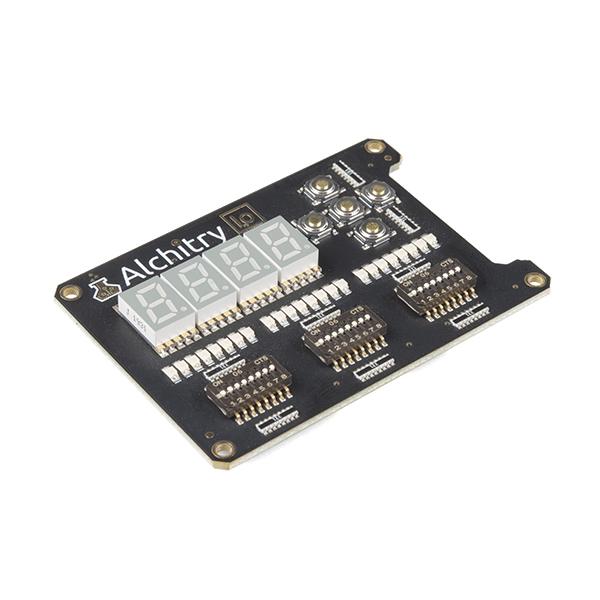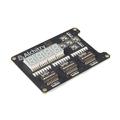Sparkfun Alchitry Io Element Board

Description Attachments
The Alchitry Io Element Board functions similarly to shields for an Arduino or HATs for a Raspberry Pi, but is specifically designed to work with Au and Cu FPGA Development Boards. It features four connectors on the lower side of the board, allowing it to snap onto an Au or Cu board. However, the Io does not feature any connection points on the upper side of the board, meaning stacking additional Elements on top of it is not possible.
One of the unique properties of the Alchitry Io Element Board is its ability to offer a hands-on experience in digital design. It allows users to physically interact with the board, making the learning process more engaging and enjoyable. The board's design also encourages experimentation, making it a fantastic tool for those looking to expand their knowledge and skills in FPGA.
The Alchitry Io Element Board features four 7-segment LED digits, five momentary push buttons, 24 LEDs, and 24 DIP switches. However, please note that the most recent revision (v2) has removed the external pull up capabilities for the R12 resistor.
For those looking to dive deeper into the world of FPGA, Sparkfun provides a range of resources, including a comprehensive FPGA Resource Page, the Alchitry Forums, and tutorials on topics such as 'How Does an FPGA Work?' and 'Programming an FPGA'. There are also project examples available, such as 'First FPGA Project - Getting Fancy with PWM' and 'External IO and Metastability'.
So, whether you're a beginner looking to get started in digital design, or an experienced designer looking to expand your skills, the Alchitry Io Element Board is a fantastic tool that offers a hands-on, engaging, and educational experience.
Properties
| Brand | Sparkfun |
| Model | DEV-17278 |
| More info | FPGA | Tutorials - learn.sparkfun.com |
| Length | 46 mm |
| Width | 66 mm |
| Height | 9 mm |
| Weight | 58 g |
Customer questions
Customer Reviews
- In stock Sparkfun Hobby Motor - Gear € 3,50 View product
- In stock Sparkfun Thin Speaker - 4 Ohm, 2.5W, 28mm € 3,- View product
- In stock SparkFun SOIC to DIP Adapter - 20-Pin € 6,25 View product
- In stock Sparkfun Teensy Stackable Header Kit (Extended) € 2,90 View product
- In stock SparkFun Logic Level Converter - Bi-Directional € 5,15 View product
- In stock Sparkfun Thumb Joystick Knob - Deluxe € 1,90 View product
- In stock SparkFun Micro 6DoF IMU Breakout - BMI270 (Qwiic) € 21,75 View product
- In stock Sparkfun Copper Tape - Conductive Adhesive, 5mm - 15 meter € 7,75 View product
- In stock Sparkfun Slide Pot - Medium (10k Linear Taper) € 3,05 View product
- In stock Sparkfun Battery Holder 2xAA with Cover and Switch - JST Connector € 2,60 View product
- In stock Sparkfun Jumper Wires - Connected 6" (M/M, 20 pack) € 5,10 View product
- In stock SparkFun Audio Jack Breakout € 2,- View product
- In stock Sparkfun LED - Ultraviolet € 2,15 View product
- In stock Sparkfun Ribbon Cable - 10 wire (3ft) € 2,- View product
- In stock Sparkfun Super Capacitor - 10F/2.5V € 6,25 View product










